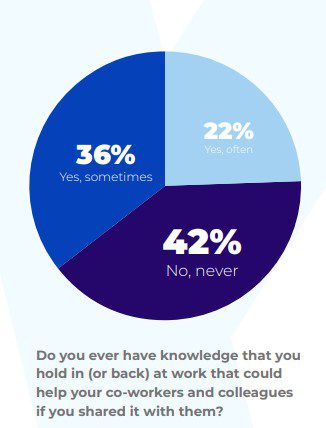Everything you need to know about ‘quiet constraint’
And how to nip it in the bud.
Why You Should Care
First it was 'quiet quitting' and then 'quiet firing' emerged.
The newest 'quiet' HR trend, as identified by Kahoot!, is 'quiet constraint'.
Here's what it is, and how to tackle it.
2022 has been the year of ‘quiet’ workforce trends.
Things kicked off in August when ‘quiet quitting’ entered the workplace lexicon. The idea that employees are disengaged at work, but instead of resigning, they are doing the bare minimum at work, and setting clear work-life boundaries.
‘Quiet quitting’ has been controversial, and begged the question whether employers should always expect workers to give 100% to their job. So long as they are completing all their tasks on time, what is the problem?
The discussion around ‘quiet quitting’, particularly in the context of the ‘Great Resignation’, triggered the emergence of so-called ‘quiet firing’.
‘Quiet firing’ is where employers chose not to tackle ‘quiet quitting’ and their disengaged workforce head on. Instead, they do nothing or actually reduce their support, and they let workers eventually resign of their own volition.
In a viral post, recruiting manager at Zapier wrote that ‘quiet firing’ “works great for companies…eventually you’ll either feel so incompetent, isolated, and unappreciated that you’ll go find a new job, and they never have to deal with a development plan or offer severance”.
But now a third ‘quiet’ trend has entered the fray – ‘quiet constraint’. Let’s find out more about this hidden workplace threat.
Move over ‘quiet quitting’ and ‘quiet firing’
A study of 1,600 US workers by Kahoot! found that while 76% are engaged and want to go the extra mile at work (meaning ‘quiet quitting’ may not be as much of an issue as previously thought), 58% are withholding valuable knowledge they could share with colleagues.

Credit: Kahoot! 2022 Workplace Culture Report.
Kahoot! coined this reality ‘quiet constraint’ and found that the reasoning was siloed teams, something which has only gotten worse in the new era of remote and hybrid teams.
When asked why they didn’t share valuable information with their teams and colleagues, 26% said they were never asked, 23% said they had no easy way to do so and 23% felt their self-expression was being stifled at work.
Interestingly, younger generations were doing this more than older groups – 77% of Gen Z were exercising ‘quiet constraint’, compared to 46% Boomers, 50% Gen X and 68% millennials.
These findings beg the question, should employers be concerned and what must they do to nip ‘quiet constraint’ in the bud? UNLEASH sat down with HR experts to find out their perspectives – here is their advice.
Don’t overlook ‘quiet constraint’
The experts that UNLEASH spoke with were not surprised by this trend, but that it is definitely something HR teams and employers should take note of.
The advent of remote work has created distributed teams, which makes it harder for managers and employees to know what their colleagues are working on.

Ally Fekaiki, founder, Juno.
“If staff lose sight of what colleagues are working on, there’s not way for them to know what information might be useful to pass on,” Juno founder Ally Fekaiki tells UNLEASH.
Natural HR’s COO and co-founder Sarah Dowzell agrees: “Teams have become more widely dispersed as remote and hybrid working becomes more common.
This reduction or removal of in-person communicating, and bonding has meant co-workers are less communicative with their insights”.
This is an innocent way of looking at ‘quiet constraint’, but there are more sinister sides – i.e. where employees are deliberating not sharing information, or they do not feel psychologically safe to do so.

Sarah Dowzell, co-founder and COO, Natural HR.
For instance, “staff who want to be first in line for promotion might wait to share new ideas to ensure that they alone get the credit, or intentionally keep learnings to themselves if they think it will help them get ahead of colleagues”, adds Fekaiki.
In other words, “employees feel that their knowledge is a commodity that makes them valuable and sharing this valuable information will lower their worth in a time of job scarcity”, notes Dowzell.
Whatever is the cause of ‘quiet constraint’ it is very clear that it is being caused by issues around culture, and this is a worry for businesses.

Sathya Smith, CEO and founder, Piper.
Sathya Smith, CEO and founder of Piper, shares that ‘quiet constraint’ “has the potential to damage relationships between team members and with management” and lead to bad business outcomes.
“It’s essential that competition does not come ahead of collaboration within a business”, according to Smith.

Eric Sydell, executive vice-president of innovation, Modern Hire.
It’s also important to remember that diverse organizations perform best because inclusive workplaces and diversity of thought breed innovation.
Plus “’quiet constraint’ appears to be another trend that falls into their category of employee disenchantment….The problem with this..is that increased risk of turnover, low productivity and poor quality of work,” adds Modern Hire executive vice-president of innovation Eric Sydell.
Prioritize communication and listening
The good news is that employees don’t want to be withholding knowledge – three in four told Kahoot! they would value a way to share knowledge with peers – workers just need organizations to fix the barriers. But where should employers start?
Given that the main cause of ‘quiet constraint’ is culture, a rethink on culture is precisely where employers should begin.

Sara Holmberg, head of HR, Winningtemp.
The trend is “a stark reminder of the need to build a culture of communication and belonging against isolation”, Winningtemp’s head of HR Sara Holmberg tells UNLEASH.
For her, Kahoot!’s research “shows that organizations are still struggling to effectively engage with their workforce and that leaders need to focus on finding out what’s really making people act under ‘quiet constraint’ and how can it be fixed”.
Accenture managing director Victoria Pelletier agrees. “In my opinion the best way to combat this is a maniacal focus on building human-centered leadership teams and positive culture”.
This “will create an environment where employees want to share information and knowledge with their co-workers”.

Victoria Pelletier, managing director, Accenture.
Listening is key here; as is having open, honest communication. For WorkJam’s managing director of EMEA Mark Williams ‘quiet constraint’ equals communication breakdown.
“Although it may seem as though employees are the ones withholding information in this trend, communication is a two-way street, and company culture always comes from the top down. Organizations must offer and offer feedback and so must their employees”.

Jesse Sacks, director of people, talent and operations, Haystack.
Ultimately, listening and open communication will help create a welcoming culture, where employees feel safe and empowered to share ideas.
Haystack’s director of people, talent and operations Jesse Sacks comments: “Psychological safety is a major contributor to organizational knowledge sharing. If someone believes that all ideas are valued and being wrong about something is OK, they’ll feel less inhibition toward sharing information – even if they are not certain how valuable it is, or how it will be received”.
Rethink recognition and rewards at work
Given that part of ‘quiet constraint’ is about competition, and wanting credit for your ideas, employers need to rethink their recognition and reward strategies. They need to find ways to reward employees for being team players and sharing their expertise, according to Juno’s Feikaki.
“Business leaders need to prioritize promoting a culture of belonging and collaboration…This can be achieved by encouraging co-workers to praise each other and implementing a culture of feedback and recognition,” shares Holmberg.

Aaron Rubens, CEO and co-founder, Kudoboard.
Modern Hire’s Sydell and Kudoboard CEO and co-founder Aaron Rubens agree on the importance of recognition and appreciation. Rubens notes: “The number one way to create a sense of belonging…is to empower a positive workforce culture built on recognition and appreciation.
“Managers or leaders are responsible for ensuring that employees feel heard, understood, and, most importantly, appreciated – even if they never step foot in a physical office space”.
Leverage technology to create connection
Another element of ‘quiet constraint’ is not having an easy way to actually share information, which has been compounded by the advent of remote, hybrid and distributed working.
While culture change is one key element to open communication, it is pretty much impossible to achieve without employees having an effective way to actually share information with each other, according to WorkJam’s Mark Williams.

Pat Ashworth, director of learning solutions, AdviserPlus.
This is where tech can come in useful, and help improve connection between disconnected teams.
However, rather than relying on individuals to spontaneously message each other on Microsoft Teams, Slack or email, AdviserPlus director of learning solutions Pat Ashworth recommends that HR teams create easy-to-use “channels where people can share their insights” – these could be named things like ‘top tips’ or ‘thought of the day’.
“Make it fun and engaging so that people want to be involved, and perhaps even create a bit of healthy competition”.

James Micklethwait, VP, Kahoot! at work
Vice-president of Kahoot! at work James Micklethwait agrees. He adds: “Technologies such as game-based learning can create incentives for knowledge sharing, promote friendly competition and make collaboration a regular part of your workplace’s routine.
“if you are intentional and use the right tools, you can create a culture of collaborative learning that supports all employees’ development while bringing the team closer together”
Using technology to help solve ‘quiet constraint’ is particularly important given that Gen Z are leading the trend, and they are a digitally native generation.
WorkJam’s Williams comments that Gen Z “deeply understand and work well with technology. Companies then must adapt and enable digital communication with their employees”.

Mark Williams, managing director, EMEA, WorkJam.
Haystack’s Sacks notes the Gen Z link. “It’s important to cultivate digital version of the ‘collision zones’ a physical office presents, in addition to making proactive steps toward opening a more diverse range of communication channels”.
Ultimately, employers who get the communication, recognition and tech elements right will be the ones who nip ‘quiet constraint’ in the bud. “This will not only help employers retain staff, but will also aid employers in achieving their wider business goals, “ concludes Williams from WorkJam.
The International Festival of HR is back! Discover amazing speakers at UNLEASH America on 26-27 April 2023.
Sign up to the UNLEASH Newsletter
Get the Editor’s picks of the week delivered straight to your inbox!

Chief Reporter
Allie is an award-winning business journalist and can be reached at alexandra@unleash.ai.
